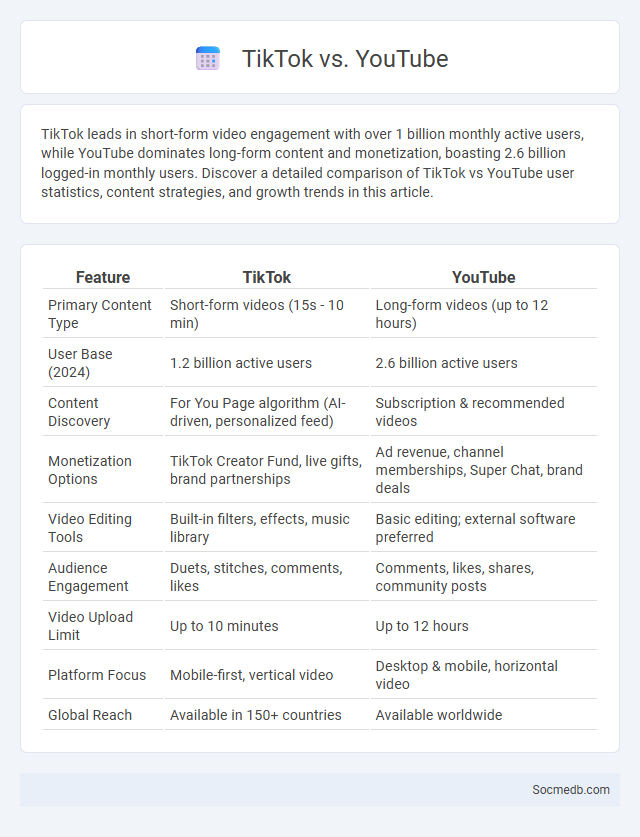
Photo illustration: TikTok vs YouTube
TikTok leads in short-form video engagement with over 1 billion monthly active users, while YouTube dominates long-form content and monetization, boasting 2.6 billion logged-in monthly users. Discover a detailed comparison of TikTok vs YouTube user statistics, content strategies, and growth trends in this article.
Table of Comparison
| Feature | TikTok | YouTube |
|---|---|---|
| Primary Content Type | Short-form videos (15s - 10 min) | Long-form videos (up to 12 hours) |
| User Base (2024) | 1.2 billion active users | 2.6 billion active users |
| Content Discovery | For You Page algorithm (AI-driven, personalized feed) | Subscription & recommended videos |
| Monetization Options | TikTok Creator Fund, live gifts, brand partnerships | Ad revenue, channel memberships, Super Chat, brand deals |
| Video Editing Tools | Built-in filters, effects, music library | Basic editing; external software preferred |
| Audience Engagement | Duets, stitches, comments, likes | Comments, likes, shares, community posts |
| Video Upload Limit | Up to 10 minutes | Up to 12 hours |
| Platform Focus | Mobile-first, vertical video | Desktop & mobile, horizontal video |
| Global Reach | Available in 150+ countries | Available worldwide |
Introduction to TikTok, YouTube, and Cross-Platform Promotion
TikTok and YouTube are leading social media platforms driving digital content consumption, with TikTok specializing in short-form videos and YouTube offering long-form content across diverse genres. Cross-platform promotion leverages the unique audiences and features of these channels to maximize reach and engagement, enabling creators and brands to build cohesive digital identities and amplify marketing campaigns. Utilizing targeted hashtags, platform-specific algorithms, and audience analytics enhances effectiveness in driving traffic and increasing visibility across multiple social media ecosystems.
Audience Demographics: Comparing TikTok and YouTube
TikTok attracts a predominantly younger audience, with over 60% of its users aged between 16 and 24, making it ideal for brands targeting Gen Z. YouTube, with its broader user base spanning various age groups, serves as a versatile platform for reaching diverse demographics, including millennials and older adults. Understanding these audience demographics allows you to tailor your content and marketing strategies effectively on each platform.
Content Formats and Engagement Features
Social media platforms offer diverse content formats including videos, stories, reels, carousels, and live streams that maximize audience reach and retention. Engagement features such as polls, quizzes, interactive stickers, and comment sections boost user interaction and foster community building. Algorithms prioritize these dynamic formats and features to enhance visibility and drive higher engagement rates across Facebook, Instagram, TikTok, and Twitter.
Algorithm Differences: How Content Goes Viral
Social media platforms use distinct algorithms that prioritize content based on engagement metrics such as likes, shares, comments, and watch time to determine virality. TikTok's For You Page uses a recommendation system leveraging machine learning to analyze user interactions, while Instagram's Explore page focuses more on personalized content discovery driven by followers' activity and trending topics. Understanding these algorithm differences is crucial for optimizing content strategies to maximize reach and increase the chances of going viral across platforms.
Influencer Marketing Strategies on Both Platforms
Effective influencer marketing strategies on social media platforms like Instagram and TikTok leverage data-driven audience targeting and authentic content creation to maximize engagement. You should collaborate with influencers who align closely with your brand values to boost credibility and foster genuine connections. Prioritizing cross-platform campaigns amplifies reach, driving higher conversion rates through tailored messaging that resonates with distinct user demographics on each platform.
Monetization Opportunities: TikTok vs YouTube
TikTok and YouTube offer distinct monetization opportunities with TikTok emphasizing creator funds, brand partnerships, and live-streaming gifts, while YouTube provides ad revenue sharing through Google AdSense, channel memberships, and Super Chat during live streams. YouTube's long-form content supports higher ad revenue potential and sustained viewer engagement, whereas TikTok's short-form videos cater to viral trends and rapid follower growth. Both platforms leverage algorithm-driven exposure, but YouTube's monetization generally favors creators with consistent, longer content and diversified income streams.
Cross-Platform Promotion: Benefits and Challenges
Cross-platform promotion on social media maximizes brand visibility by leveraging multiple channels such as Facebook, Instagram, Twitter, LinkedIn, and TikTok, enabling businesses to reach diverse audiences and increase engagement rates. This strategy enhances content consistency and strengthens brand messaging, but it also presents challenges like maintaining platform-specific content relevance and managing varied algorithmic behaviors. Effective analytics tools and tailored content strategies are essential to navigate these complexities and optimize cross-platform marketing performance.
Best Practices for Integrating Content Across Platforms
Consistently tailoring content to fit the unique formats and audiences of each social media platform enhances engagement and brand coherence. Utilizing a unified content calendar ensures synchronized posting schedules, maximizing reach and maintaining audience interest. Leveraging cross-platform analytics tools provides actionable insights for optimizing content performance and strategic adjustments.
Case Studies: Brands Winning with Cross-Platform Strategies
Leading brands like Nike, Starbucks, and Adidas demonstrate the effectiveness of cross-platform social media strategies by tailoring content for Instagram, TikTok, and Twitter, resulting in heightened engagement and brand loyalty. Case studies reveal that leveraging platform-specific features such as Instagram Stories, TikTok challenges, and Twitter polls significantly boosts campaign reach and user interaction. Data shows these brands achieve up to 40% higher conversion rates when their messaging is consistent yet uniquely adapted across multiple social channels.
Conclusion: Choosing the Right Approach for Your Goals
Selecting the right social media strategy depends on aligning platforms and content types with specific business objectives such as brand awareness, lead generation, or customer engagement. Data-driven analysis of audience demographics and behavior optimizes campaign effectiveness, ensuring resource allocation maximizes return on investment (ROI). Continuous performance monitoring and agile adjustments support sustained growth and achievement of measurable social media goals.
 socmedb.com
socmedb.com